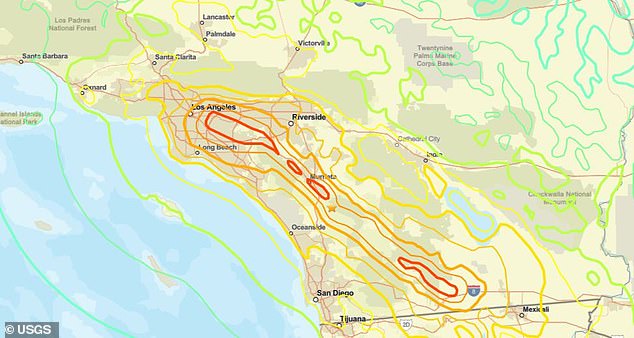
23 Million Americans Face Violent Quake Threat from Little-Known Fault, Scientists Warn
Southern California’s Hidden Threat: The Elsinore Fault and the Looming “Big One”
[Image: USGS simulation of a 7.8 magnitude quake along the Elsinore fault, showing widespread shaking across Southern California.]
A recent 5.2 magnitude earthquake near San Diego has reignited fears of the “Big One”—a catastrophic quake long predicted for California. While the San Andreas Fault often dominates doomsday discussions, scientists warn the lesser-known Elsinore Fault could be the real threat.
The Elsinore Fault: A Silent Giant
Part of the San Andreas system, the 110-mile Elsinore Fault stretches from the U.S.-Mexico border through San Diego and Riverside Counties toward Los Angeles. Despite its size, it’s been eerily quiet, with its last major quake (6.0 magnitude) in 1910. However, seismologist Dr. Lucy Jones notes it’s capable of a 7.8 magnitude event—similar to San Andreas’ worst-case scenario.
“The Elsinore is a major risk,” Jones warned after Monday’s quake. Data suggests such faults rupture every 100–200 years, meaning Southern California may be overdue.
Simulating Disaster
[Image: Map showing projected shaking intensity from a 7.8 quake on the Elsinore-Whittier faults, with Los Angeles in high-risk zones.]
A 2017 USGS simulation of a 7.8 quake on the Elsinore and connected Whittier faults paints a grim picture:
- Los Angeles could face violent shaking (MMI 7.5–9.0), causing structural collapse, injuries, and economic chaos.
- San Diego might experience moderate damage (MMI 4.0–6.5), including cracked walls and collapsed chimneys.
- Las Vegas, 300 miles east, could feel tremors (MMI 4.5), highlighting the quake’s far-reaching impact.
Over 23 million people across Southern California and beyond would be affected.
Why Elsinore Matters
The Elsinore Fault’s proximity to major cities amplifies its danger. While the San Andreas garners more attention, Dr. Jones explains the system splits into four faults in Southern California, with Elsinore being a “junior sister” capable of cascading stress to neighboring faults.
Historically, seismic lulls follow major quakes. The 1992 Landers (7.3) and 1994 Northridge (6.7) quakes reduced tectonic stress, leading to quieter decades. But activity is rising again, mirroring 1980s patterns.
A History of Destruction
The San Andreas’ 1906 San Francisco quake (7.9 magnitude) killed 3,000 and destroyed 80% of the city. A similar “Big One” today could claim 1,800 lives and injure 50,000 statewide. While Elsinore’s quakes are less frequent, their potential scale demands equal preparedness.
[Image: Dr. Lucy Jones discussing earthquake risks, with a caption highlighting increased seismic activity.]
Conclusion
Southern California’s earthquake hiatus may be ending. With the Elsinore Fault’s threat looming, experts urge updated infrastructure and emergency plans. As Jones notes, “We’re having more felt quakes than in decades.” Whether the next disaster strikes from San Andreas or its quieter sibling, readiness is key to survival.
(Word count: 598)


